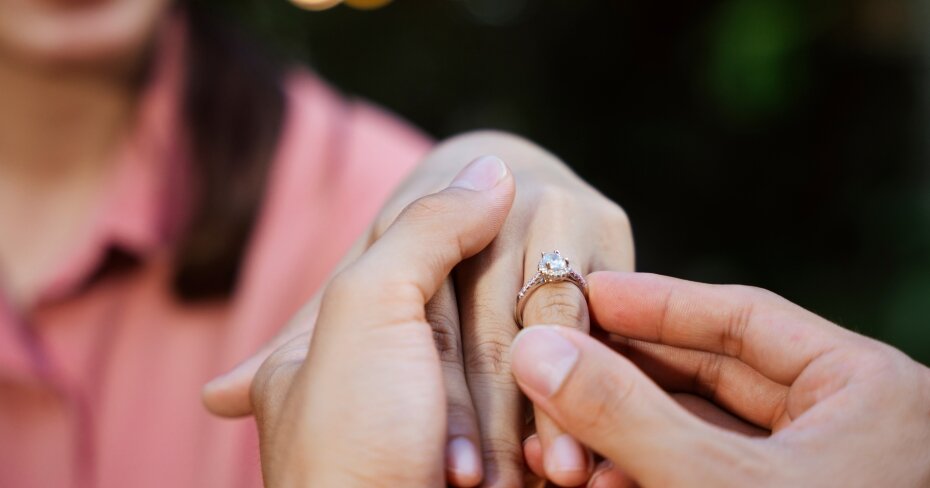What’s the best way to insure my engagement and wedding rings?
By: Lisa Coxon on May 28, 2024
This article has been updated from a previous version.
For many, part of the ritual of getting engaged is flashing the new rock on one’s ring finger to family, friends, and on social media. An engagement ring is a symbol of their loving commitment. It's also a valuable item that is worth protecting against damage and loss.
The same long-term commitment you’ve made to your partner should also be reflected in how you protect your new asset. These items carry a lot of sentimental value, not to mention actual cash value.
So, should you insure them under your home or tenant insurance policy, with a jewelry insurance provider, or simply rely on the warranty from the jeweler? What’s the best way to insure your engagement or wedding ring?
In this article:
Appraisal before insurance
No matter which way you decide to insure your ring, it’s important to first find out how much the ring is worth, since this is a determining factor in the level and cost of coverage you’ll get.
It’s best to have the ring appraised by either a certified appraiser or a jeweler. The cost for this service can vary. Some appraisers will charge a flat rate for the service, while others might take a percentage of the value of the ring as their fee.
Appraisals shouldn’t be a one-time deal, either. Because global markets are constantly in flux, the value of your ring is going to change, depending on what gemstones or precious metals it’s made from and what those materials are currently being sold for.
Industry recommendations for how often to appraise range from every two to five years. (Whenever you get an updated appraisal, you should tell your insurance provider, since you don’t want to risk being underinsured. The updated value could also change your premium.)
Some companies will provide a service called an “Insurance Value Adjustment (IVA).”
“This feature will automatically adjust the insurance value of insured items when an updated appraisal has not been received for a period of time,” says Bryan Howard, director of product and risk management at Jewelers Mutual, which provides personal jewelry coverage for those 18 years or older in the U.S. and in Canada (except for Quebec).
“This adjustment is based on the latest results for Jewelry and Watches within the Consumer Price Index and protects the customer from their jewelry items being underinsured,” says Howard.
Once you’ve got a good handle on the value of your ring, you can start doing your research on which path you want to take to insuring it.
What is a jewelry warranty?
Unlike jewelry insurance, a jewelry warranty focuses on specific repairs or services for only a specific period after the purchase is made.
Often (but not always) offered by the jewelry manufacturer, the warranty usually covers issues caused by how it was made, like loose stones or broken parts.
“Each company is unique in what they offer in terms of their cost and level of coverage,” says Howard. “Warranty products will cover damage to the item and maybe a few types of losses, such as where they lose a piece of the item that they purchased. Insurance policies tend to be a little more comprehensive from that standpoint, where they’ll cover things like theft and damage to the item.”
It may also offer services like cleaning or resizing. However, a warranty won’t protect your jewelry against things like loss or damage, so getting your jewelry item insured is still important.
Related: Home insurance coverage you need for jewelry and art
Should you insure engagement and wedding rings under your home insurance policy?
One of the most common ways to insure an engagement or wedding ring is under your condo, tenant or home insurance policy.
Insuring your ring this way is relatively straightforward, since you can keep all your property insurance with one company. However, most home and tenant insurance policies will include only a base amount of coverage for jewelry, or a limit — usually around $6,000 or less for each claim you make.
So, your first step should be looking at the policy language to determine what the cap is for jewelry items, and whether you’ll need to purchase additional coverage (called an “endorsement”) in order to fully cover the cost of the ring.
Typically, home and tenant insurance policies will cover loss of or damage to the ring. The specific amount of coverage is usually determined by figuring out how much it would cost to replace the ring, as well as other factors like where it’s being stored and who’s wearing it.
If you need to make a claim for loss or damage to the ring, you would contact your home or tenant insurance company.
Depending on the company, you might be able to obtain an actual cash value for the ring (though keep in mind that your provider will consider how much the ring has depreciated in value since you bought it), or a replacement ring that’s similar in quality and type.
You may need to hand over any receipts from appraisers or the jeweler from which you bought the ring.
Read more: Tenant insurance safeguards your stuff — and your peace of mind
Insuring engagement and wedding rings via a jewelry insurance provider
Another way to insure your engagement and wedding rings is to buy standalone jewelry insurance from a jewelry insurance company.
But no matter where you purchase insurance from, Howard recommends doing your research and sifting through the policy language to see what amount and type of coverage you’re getting with each provider.
Each company will ask for different information, but you should be prepared to provide information such as:
- The value of the ring,
- Who is going to be wearing it (and how often),
- Where it’s going to be stored, and
- How it will be used.
These factors will determine the level of coverage, with deductibles that can range anywhere from $0 to $25,000, depending on the value of the ring, says Howard.
Once insured, you should be covered against loss, theft, or damage to the ring.
“Let's say you hit your engagement ring on the side of the table and you chip the stone or bend or break the prong or setting that holds the stone in place,” says Howard. “Those are typically types of perils or losses that are covered in our policy language.”
It’s possible to insure multiple items under one policy.
Whether you choose to add your wedding ring to your home insurance or get standalone jewelry insurance, make sure to know your ring’s value through an appraisal first. Regular appraisals are needed to keep up with market changes. Ultimately, the goal is to secure the ring’s coverage, giving you peace of mind.
“The minute that it leaves the jewelry store,” says Howard, “it’s the individual’s responsibility to ensure that it’s protected.”
Read next: How to make an inventory list for home insurance
Compare 50+ quotes from Canadian providers in 3 minutes.

.jpg?itok=csBN-HRa)
